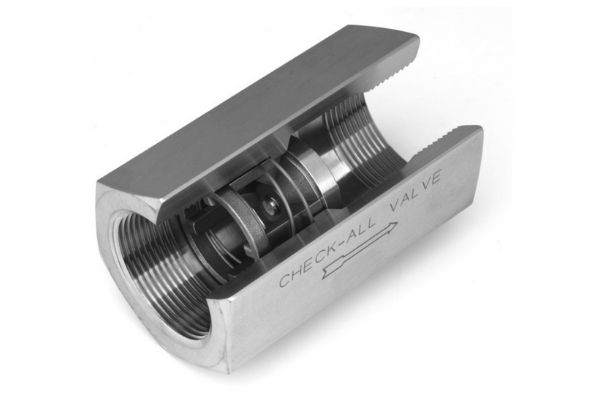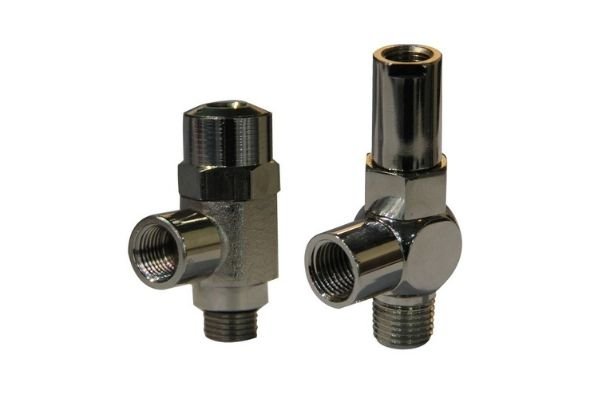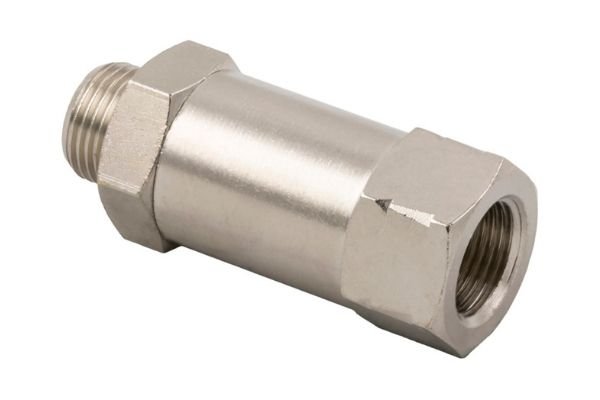Inline check valves are commonly found in compressed air systems to stop the backward flow of pressurized air. This article will provide you with all the relevant information on them and where to purchase them!
Table of Contents
- What are Inline Check Valves?
- Where are Inline Check Valves?
- How do Inline Check Valves Work?
- Spring-Loaded Inline Check Valve
- Inline Check Valve Buying Guide
- Inline Check Valves Available on Amazon
- FAQs (Frequently Asked Questions)
What are Inline Check Valves?

Air compressor inline check valves, otherwise known as non-return valves, are components used in air compressor systems to control the flow of air. Check valves essentially let air flow through them but not against them, so they’re perfect for ensuring that the compressed air can’t flow backward.
They get the nickname non-return valves as they have two ports, one for allowing the pressurized air to enter (inlet) and one for allowing the pressurized air to exit (outlet), with the air being allowed only to flow in one direction and not return.
This is why check valves are not only placed in the tank but also in the lines. For more information on tank check valves visit our guide!
Where are Inline Check Valves?
As true to their name as they could possibly be, inline check valves can be found inline on air compressor lines, hoses, or piping networks. They typically are available with both female or male thread ends so that they can easily fit into existing lines.
However, since they are inline to the air compressor system, they must be fully removed from the line to be inspescted or to perform any maintenance.
How do Inline Check Valves Work?
Inline check valves rely heavily on differential pressure to work effectively. They require a pressure on the inlet side to be higher than the pressure on the outlet side to allow the valve to open and allow airflow through. When the pressure of air on the outlet side of the valve is higher than the pressure on the inlet side of the valve, the valve will close – essentially preventing the backflow of pressurized air.
A few important features involved in the successful operation of an inline check valve are its closing mechanism, cracking pressure and, installation orientation. The closure mechanism on valve types will vary, but unlike other valves, they do not need a handle, lever, or actuator to work effectively. Depending on the design, the closing mechanism typically involves a back pressure pushing a gate, ball, diaphragm, or disc against the orifice and sealing the valve closed.
The cracking pressure is the required minimum upstream pressure that the valve needs to open and allow through it. The specific cracking pressure changes based on the valve design and its size, so you must ensure that your air compressor system generates this cracking pressure to ensure the selected inline check valve is suitable. For more information on check valve cracking pressure, visit our guide!
You must ensure that the valve is installed in the correct orientation for it to work correctly. More often than not, there will be an arrow on the inline check valve which will indicate the flow direction. So as long as you install it correctly the air will move through the system as intended.
Spring-Loaded Inline Check Valve
Inline spring-loaded check valves are one of the most inline check valves available due to they simple design and easiness to understand. When the flow of air enters the valves intlet, it has to have enough pressure force to overcome the cracking pressure and spring force. When it overcomes the cracking pressure, it pushes the disc which in turns opens the orifice plate and allows the flow of air to move through the valve.

Then, when the input pressure is no longer enough, there is backpressure. This backpressure and spring push the disc again the orifice and seal the valve shut. The reaction time for closing is quick due to the short distance the disc must travel and the springs help.
This type of valve design helps prevent against the pressure surges in the compressed air lines and can be installed in either horizontal or vertical orientations. The YouTube animation below is a very good tutorial on how a spring loaded check valve works.
Inline Check Valve Buying Guide
First, you must select a material suitable for your medium, in our case, air. The most common materials to use for inline check valves on compressed air systems are typically brass or stainless steel. Brass has excellent properties for applications using air, water, and oil. However, it is typically less resistant to heat and corrosion than stainless steel check valves. Stainless steel has superior corrosion resistance, heat resistance, low-temperature resistance, and very good mechanical properties.
Other important considerations are the line size for connection points, the maximum pressure and cracking pressure requirements. You must ensure you buy an inline check valve with the right size threads, one that is capable of operating at your system pressure, and even one that has a low enough cracking pressure to ensure the valve works correctly at your system pressure.
Consider whether you wish to install the inline check valve horizontally or vertically, and make sure you pick a product suitably! I will now provide you with some examples of inline check valves available online.
Inline Check Valves Available on Amazon
I have picked out a couple inline check valves readily available on Amazon. The first is a female to female Brass 3/4″ inline check valve.
- ✅DESIGN- Designed to prevent water from traveling back to the source to prevent contamination, the check valve features is a stainless steel spring.
Prices pulled from the Amazon Product Advertising API on:
Product prices and availability are accurate as of the date/time indicated and are subject to change. Any price and availability information displayed on [relevant Amazon Site(s), as applicable] at the time of purchase will apply to the purchase of this product.
Below, I have picked out an example of a male to male Brass 1/4″ inline check valve.
- Can be used as a tank check valve for small compressors or as a component in pneumatic circuits
Prices pulled from the Amazon Product Advertising API on:
Product prices and availability are accurate as of the date/time indicated and are subject to change. Any price and availability information displayed on [relevant Amazon Site(s), as applicable] at the time of purchase will apply to the purchase of this product.
FAQs (Frequently Asked Questions)
A pneumatic check valve is a device which is inserted either in tank or inline in a pneumatic system. They essentially stop the backflow of pressurized air which protects equipment and prevent contamination due to reverse flow. Also referred to as one-way valves, they allow you to keep certain parts pressurized while others areas are de-pressurized. 
There is a wide array of valves that are used on compressed air systems. These include solenoid valves that are electromechanically operated, and consists of electric coil that converts electrical energy into linear motion in order to open or close a valve. There are also air operated valves that are powered by air pressure against a piston or diaphragm to produce a linear or circular movement which operates the valve. Finally, a mechanical pneumatic valve which is operated either by a mechanism or operator. 
Compressed air check valves work based on a pressure differential from one side of the check valve to the other. For the valve to work and air to flow through it, the pressure must be greater at the inlet than it is at the outlet. The moment this swaps, and the pressure is higher at the outlet, the valve will close and no pressurized air will be allowed to flow backwards.
A non-return valve is simply another name for a check valve. They function in the exact same manner, allowing a medium to only flow in one direction and preventing backflow. 
A non-return valve works via the pressure of air at the inlet being greater than the pressure at the outlet. This allows the valve to be open and air flown through it. When the pressure is greater at the outlet than the inlet, the valve is forced close which in turn keeps the pressurized air from flowing backwards.
Additional valve reading:
- Types of Compressed Air Valves – Guide To Pneumatic Valves
- Pneumatic Flow Control Valves – What Are They, How Do They Work?
- Check Valve Sizes
- What is Check Valve Cracking Pressure
- Air Compressor Troubleshooting Check Valve
- Air Compressor Unloader Valve Explained
- Unloader Valves On Twin V Piston Compressor Guide
- 5 3 Valves Explained
- 5-2 Air Valves
- 4-2 Compressed Air Valves
- 3-2 Air Valves
- Drawing a 5/3 compressed air valve
- Draw A 5/2 Air Valve
- Pneumatic Soft Start Valves
- Solenoid Pilot Air Valves
- Compressed Air Solenoid Valve Guide
- Air Compressor Auto Drain Valves Guide
- Needle Valve vs Ball Valve
- Globe Valve vs Ball Valve
- Globe Valve vs Gate Valve
- Butterfly Valve vs Gate Valve
If you have any questions regarding air compressor inline check valves, please leave a comment below, with a photo if applicable, so that someone can help you!


